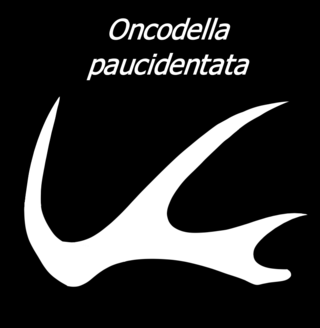The following fossiliferous stratigraphic units are found in Cyprus.
The following fossiliferous stratigraphic units are found in Cyprus.

Obinautilus is an extinct genus of shelled cephalopod that has been variously identified as an argonautid octopod or a nautilid. It is known from the Late Oligocene to Pliocene of Japan. The shell is discoidal and very involute, with rapidly expanding and compressed whorls, fine radial ribs, a rounded venter with a shallow furrow, and almost closed umbilicus.
Argonauta tokunagai is an extinct species of octopus. It was described in 1913 based on fossil material from the Middle Miocene Huzina Formation of Japan.

Heterastridium is an extinct genus of marine hydrozoan. It is the only accepted genus in the monotypic family Heterastridiidae. The fossils date from the Upper Triassic. They are mostly discoid or spherical and some forms found in the Karakorum mountains are called Karakorum stones. They vary in diameter from 1 to 35 cm and appear to follow Cope's rule for the prehistoric climate.

The Kugitang Formation or Group is an Oxfordian geologic formation in Tajikistan and Uzbekistan and a geologic group in Turkmenistan. Dinosaur remains diagnostic to the genus level are among the fossils that have been recovered from the formation.
Argonauta oweri is an extinct species of argonautid octopus. It is known from the early Pliocene of New Zealand.
The Cercado Formation is a geologic group in Dominican Republic. The formation comprises siltstones, limestones, claystones, sandstones and conglomerates deposited in a shallow marine to reef environment. The Cercado Formation, unconformably overlying the Baitoa Formation, preserves bivalve, gastropod, decapod and coral fossils dating back to the Late Miocene to Early Pliocene period.
The Hassberge Formation is a geologic formation in Bavaria, Germany. It preserves fossils dating back to the Carnian stage of the Triassic period.
The Kössen Formation is a Late Triassic (Rhaetian-age) geological formation in the Northern Calcareous Alps of Austria and Germany, in the Tiroler-Lech Nature Park. During the Late Triassic, the area now occupied by the Northern Calcareous Alps was instead a long, passive coastline at the western tip of the Neotethys Ocean. The environment was initially dominated by a wide and shallow carbonate platform within a lagoon between the shore and a string of reefs. This carbonate platform is nowadays preserved as the Carnian to Norian-age Hauptdolomit and Dachstein Formation. The Kössen Formation represents a period of increased siliciclastic clay input into the lagoon, covering up the carbonate platform with marls and marly limestones instead of pure limestone or dolomite. The Eiberg Member of the Kössen Formation was deposited in the Eiberg basin, a narrow strip of deeper water which developed between the carbonate platform and the shoreline in the later part of the Rhaetian.
The Vigla Formation is an Early Cretaceous geologic formation found mostly in Albania and Greece.
The Oberrhaet Formation, also known as the Oberrhaet Limestone, is a Late Triassic (Rhaetian-age) geological formation in Austria. It is a unit of massive dark grey bioclastic limestones, found within the Northern Calcareous Alps. The Oberrhaet Limestone was originally a series of reefs which developed on the northwest edge of the Eiberg Basin, a narrow marine waterway extending along the northwestern tip of the Neotethys Ocean. The center of the Eiberg Basin is nowadays preserved as the Eiberg Member of the Kössen Formation, which was deposited southeast of the Oberrhaet Limestone and interfingers with it in many areas. The Oberrhaet Limestone was very similar to the Dachstein Limestone, which represented carbonate platforms and reefs on the southeast edge of the Eiberg Basin. The most prominent components of the reefs were giant frond-like colonies of Retiophyllia, a scleractinian coral.

Oncodella is an extinct genus of Late Triassic conodont. The genus was given the type species Oncodella idiodentica by Mosher (1968), on the basis of fossils from the Late Triassic of Austria. However, Mosher (1969) later revised the species name to Oncodella paucidentata, since identical fossils from the same area were previously given the name Hindeodella paucidentata by Mostler (1967).